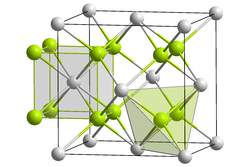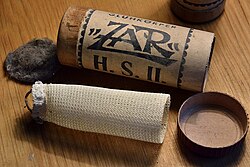Thorium
Thorium is a chemical element in actinide group. It is a weakly radioactive metal. It has a shiny, silvery white color. It has the chemical symbol Th and the atomic number 90. Natural thorium has an atomic weight of 232. Thorium is named after Thor, the Norse god of thunder. Its ores are found in nature (that is, on Earth), especially in India, the United States, and Australia.
Thorium would make a good source of nuclear fuel because it makes much less waste and is four times as common as uranium. It does not need the wasteful process of enrichment. It makes 3,200,000 times as much energy as coal and 200 times as much energy as uranium. Scientists believe that there is enough of it to power the world for thousands of years. Thorium has been used for various purposes since the 19th century. It is an alloying agent in magnesium and is also used as an industrial catalyst.
Thorium is safer than uranium. This is because thorium cannot undergo nuclear fission on its own. Usually, plutonium is need to start and maintain a reaction. This is why thorium is considered better for nuclear reactors. Also, nuclear waste from thorium reactors contains far smaller amounts of dangerous transuranic elements than waste from uranium reactors.[1]
Estimates of Thorium that can be mined
Estimates of mineral resources have been made about how much Thorium is available to be mined from different countries,
| Country | Total thorium resources, tonnes |
Remarks |
|---|---|---|
| [800,000 or] 846,477 | [2] | |
| [600,000 or] 632,000 | [3] | |
| [500,000 or] 595,000 | [4] | |
| [500,000 or] 595,000 | [5] | |
| 381,000 | Historical data[6] | |
| 380,000 | Historical data[7] | |
| 300,000 | Historical data[8] | |
| [ 170,000 or] 172,000 | [9] | |
| [ 150,000 or] 155,000 | [10][11] | |
Thorium Media
The 4n decay chain of 232Th, commonly called the "thorium series"
Thorium dioxide has the fluorite crystal structure. Th4+: __ / O2−: __
The radiogenic heat from the decay of 232Th (violet) is a major contributor to the earth's internal heat budget. Of the four major nuclides providing this heat, 232Th has grown to provide the most heat as the other ones decayed faster than thorium.
Jöns Jacob Berzelius, who first identified thorium as a new element
World War II thorium dioxide gas mantle
Glenn T. Seaborg, who settled thorium's location in the f-block
References
- ↑ Griffin H.C. 2010. Natural Radioactive Decay Chains. In Vértes A.; Nagy S.; Klencsár Z.; et al. (eds). Handbook of Nuclear Chemistry. Springer Science+Business Media. p. 668. ISBN 978-1-4419-0719-6
- ↑ International Atomic Energy Agency 2019, p. 68.
- ↑ International Atomic Energy Agency 2019, p. 39.
- ↑ International Atomic Energy Agency 2019, p. 99.
- ↑ International Atomic Energy Agency 2019, p. 106.
- ↑ International Atomic Energy Agency 2019, p. 26.
- ↑ International Atomic Energy Agency 2019, p. 50.
- ↑ International Atomic Energy Agency 2019, p. 47.
- ↑ International Atomic Energy Agency 2019, p. 29.
- ↑ International Atomic Energy Agency 2019, pp. 21-22.
- ↑ International Atomic Energy Agency 2019, p. 83.








